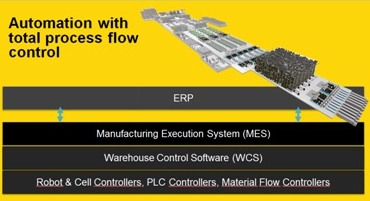Smithers Rapra, one of the world’s leading sources of information on polymers, plastics, rubber and adhesives, recently published a report stating that the global tire manufacturing industry is set to grow almost at a pace of four percent per year from now through to 2022. There are many key factors and industry trends that are driving this growth, but a large percent of that growth can be contributed to the innovations in tire technology which are then furthering advancements in automation within tire manufacturing and distribution facilities.
These advancements are not only benefiting new facilities (Greenfields), but also existing facilities (Brownfields) that were developed with only manual operations in mind. Large tire retailers are beginning to realize what automating their entire facilities or even a few parts of their handling process can do to their bottom lines. Over the last decade, automation has touched each area in the tire manufacturing/handling process and also allowing distribution center operators to realize what this can do to their bottom lines as well.
Automating Each Step in the Process
Legacy Brownfields were designed with manual processes for the handling of their tires, and as a result have typically been perceived as automation-unfriendly. However, with advancements in automation, modules can be customized to each process and each facility, causing an accelerated adoption rate.
Breaking Down the Process Areas
- The first process is the automatic storage and transportation of raw rubber and other basic ingredients. During this process, raw materials are placed into automatic storage and automatic retrieval (AS/RS) systems.
- Raw materials are then delivered by automation to various mixing and preparation processes to be made into compounded materials for component preparation.
- These materials are then delivered by automation to component preparation machines.
- The next step is the green tire building process, which receives components automatically.
- From there green tires are automatically unloaded from tire building machines (TBMs) by robots.
- The green tires are then automatically moved by green tire storage and retrieval gantries or crane style AS/RS systems.
- Automatic guided vehicles (AGV) or an overhead electrified monorail systems (EMS) then deliver green tires to the curing press.
- After curing, final quality checks on the finished products are completed within fully automated cells.
- The tires are then sorted and placed on pallets using gantry robots.
- Order fulfillment and shipping automation is the final step. This is where the customer orders are picked by gantry systems and then sequenced into a trailer for customer delivery.
For facilities that do not have the ability to automate all at once, they can deploy modular automation in sequential steps. Modular automation is able to be built and configured in elemental steps to meet their planning requirements. The systems are modular from raw materials to palletizing. There’s a shorter delivery and installation time due to this standardization concept and can be easily applicable to any factory.
Experiencing the Benefits
Whether automating part or all of the handling process, customers are seeing the necessary return on investments (ROI). They’ve begun to see the following savings and benefits:
- Total process flow control and visualization of manufacturing/distribution processes at each stage.
- Increase in productivity. For example, customers can manufacture 5 to 10 percent more tires per day by getting the right Work-in-Process (WIP) and/or product in the right place at the right time.
- With complete communication between the facility’s WMS, MES and ERP systems as well as interface to PLCs, robot controllers and upper host, facilities have 100 percent tracing of total tire production history. This means they can quickly see the progression of the tires from materials and components to green tires (GT) to finished tires (FT).
- Real-time data for inventory management, which enables 100 percent availability of materials, components and tires in each process.
- With an optimized layout design, less space is needed. This means customers can minimize the required factory footprint, which in turn minimizes the need for large capital investments.
- Just-in-Time (JIT) delivery to different processes areas as well as to the end customer.
- Streamlined material flow that allows facilities managers to minimize buffering, have less WIP and maximize efficiency.
- Reduction in waste and scrap.
- Better ergonomics and allocation of human resources. This results in fewer health and safety labor-related problems.
- Flexibility with operations and processes. Customers have ability to make automatic changes based on needs and demands.
Implementing for the Future
With rising customer demands and tire sales predicted to spike, tire manufactures are seeking ways to maintain their share of the market by implementing the latest automated systems or upgrading individual processes, which in turn gives them more of a chance to maintain/gain market share.
Because they’re tailored for each manufacturing and distribution process and can be installed in new and existing plants (as either a one-time deployment or independently through scalable, modular automation implementations), the time is now to automate. It ensures your bottom line keeps stacking up.
Author Bio:
Don Heelis is a mechanical engineer and senior systems sales manager for Cimcorp, a manufacturer and integrator of turnkey robotic gantry-based order fulfillment and tire handling solutions. With more than 25 years of experience, Heelis helps customers develop fully automated systems that increase efficiency, accuracy and throughput for manufacturing, warehouses and distribution centers around the world.


